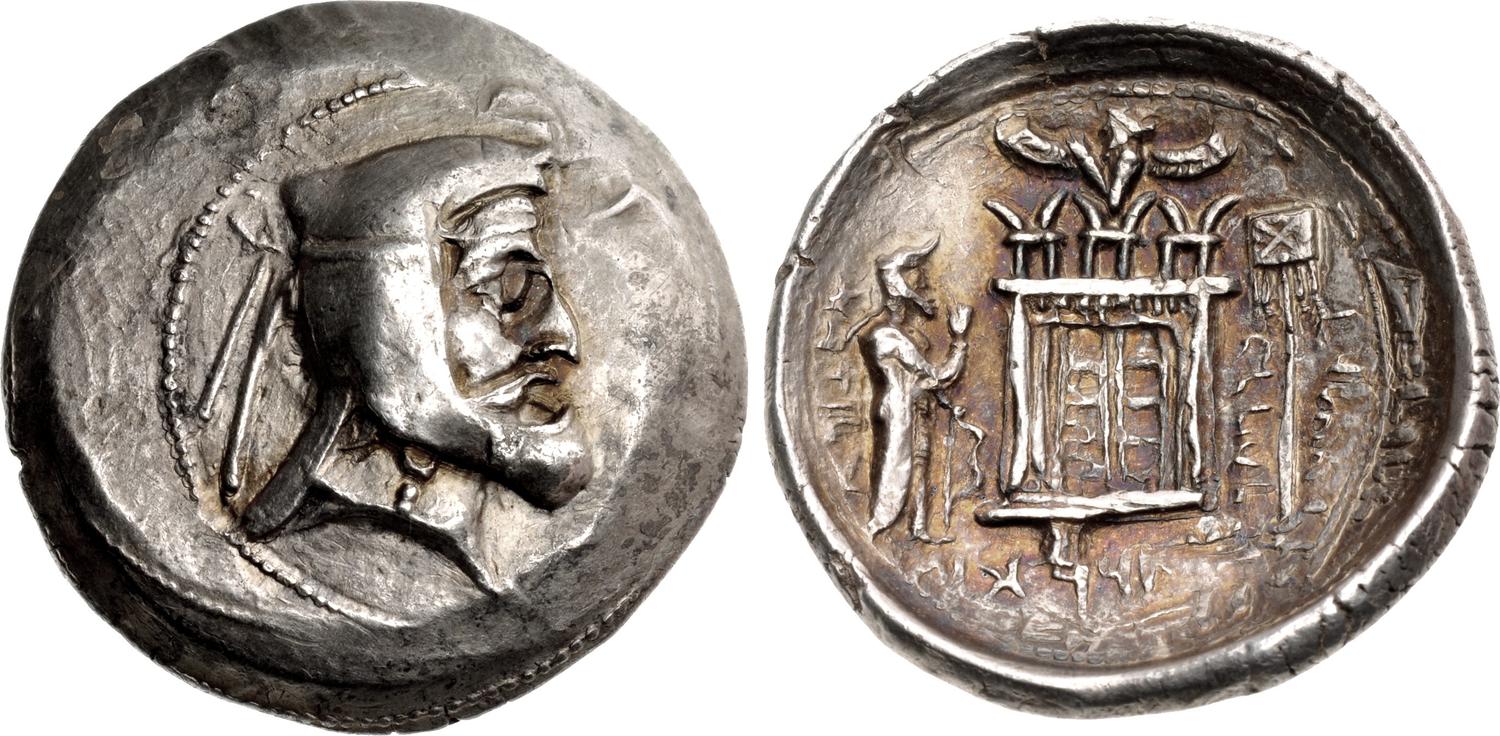240 BCE - 200 BCE | wtpr in Aramaic to outer right; p in Aramaic to inner right; (lh' in Aramaic) in exergue: "Vadfradad, the Frataraka of the Gods, Son"
Overstriking coin
Vadfradad_I_CNG, _108, _16_May_2018, _410.jpg
[1]
Overstruck variety
Baydad Classical Numismatic Group, 393, 15 Mar 2007, 202.jpg
[2]
|
|
Sale(s)Sale(s) ᵖ:
|
Classical Numismatic Group, 108, 16 May 2018, 410
|
|
|
|
Description
| ObverseInscription or printing placed on the obverse.:
|
Head of Vadfradat right, wearing earring, satrapal cap (kyrbasia) and diadem. Border of dots.
|
ReverseInscription or printing placed on the reverse.:
|
wtpr in Aramaic to outer right; p in Aramaic to inner right; (lh' in Aramaic) in exergue: "Vadfradad, the Frataraka of the Gods, Son" (Aramaic) Fire Temple with half-figure of Ahura-Mazda, to left, satrap standing right, in prayer and bow, to right, standard. Border of dots.
|
Mint and issuing power
| MintIdentifies the place of manufacture or issue of a numismatic object.:
|
Istakhr (Persepolis)
|
Ancient regionAncient region.
|
Persis
|
Modern countryModern country: Iran
|
AuthorityIdentifies the issuing power. The authority can be "pretended" when the name or the portrait of X is on the coin but he/she was not the issuing power. It can also be "uncertain" when there is no mention of X on the coin but he/she was the issuing power according to the historical sources:
|
Kingdom of Persis, Vadfradad II of Persis
|
Chronology
| FromIdentifies the initial date in a range assigned in a numismatic context. 240 BCE toIdentifies the final date in a range assigned in a numismatic context.. 200 BCE
|
Hellenistic 323-30 BC  periodTime period of the numismatic object. periodTime period of the numismatic object.
|
Physical description
MetalThe physical material (usually metal) from which an object is made.: Silver 
|
WeightWeight of the numismatic object (in grams). in grams: 16.2416.24 g <br />16,240 mg <br />
|
DenominationTerm indicating the value of a numismatic object. Examples: tetradrachm, chalkous, denarius.: tetradrachm 
|
AxisDescribes the directional relationship between the obverse and reverse of a numismatic object.: 55 mm <br />0.5 cm <br />
|
| DiameterDescribes diameter of an object (in mm).: 24.524.5 mm <br />2.45 cm <br />
|
StandardStandard.: Attic
|
References
Description
| ObverseInscription or printing placed on the obverse.:
|
Head of Baydat right, with short beard and mustache, wearing earring, satrapal cap (kyrbasia) with flaps tied behind and diadem. Border of dots.
|
ReverseInscription or printing placed on the reverse.:
|
"Baydad, son of Bagawart, dynast of Fars" (Aramaic) Fire Temple of Ahura-Mazda. To left, king standing right, in prayer. To right standard. Border of dots.
|
Mint and issuing power
Chronology
| FromIdentifies the initial date in a range assigned in a numismatic context. 300 BCE toIdentifies the final date in a range assigned in a numismatic context.. 250 BCE
|
Hellenistic 323-30 BC  periodTime period of the numismatic object. periodTime period of the numismatic object.
|
Physical description
| DenominationTerm indicating the value of a numismatic object. Examples: tetradrachm, chalkous, denarius. ᵖ:
|
tetradrachm 
|
StandardStandard. ᵖ:
|
Attic
|
| AxisFrom 1 to 12 by analogy with the clock hours. ᵖ:
|
3<ul><li>No units of measurement were declared for this property.</li> <!--br--><li>"" is not declared as a valid unit of measurement for this property.</li></ul>
|
References
| Coin type referenceReference to coin series study ᵖ:
|
Sear II5Sear II, n° 6186, Alram 19861Alram 1986, n° 515, Klose - Müseler 20082Klose - Müseler 2008, 2/3, Nelson 20113Nelson 2011, n° 560, Van't Haaff 20204Van't Haaff 2020, p. 64-65, n° 515
|
| Coin series web reference overstruckCoin series web references overstruck:
|
|
References
- a b Alram, Michael (1986), Iranisches Personennamenbuch. Band IV: Nomina Propria Iranica In Nummis, Vienna.
- a b Klose, Dietrich O. A. - Müseler, Wilhelm (2008), Statthalter Rebellen Könige - Die Münzen aus Persepolis von Alexander dem Großen zu den Sasaniden, Munich, xii, 90 p.
- a b Nelson, Bradley R. (2011), Numismatic Art of Persia: The Sunrise Collection Part I: Ancient- 650 BC to AD 650, Lancaster
- a b van't Haff, Pieter Anne (2020), Catalogue of Persis Coinage, Ca. 280 B.C. - A.D. 228, 2020
- ^ Sear, David R. (1979), Greek coins and their values. Vol. II, Asia and North Africa, London, xlviii, p. 317-762

